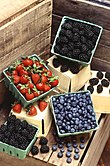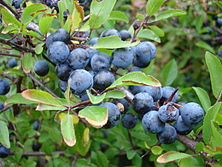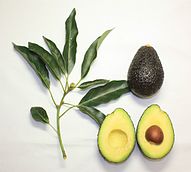Berry (botany)

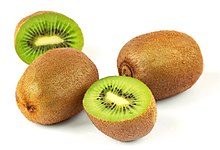
In botanical terminology, a berry is a fleshy fruit without a stone produced from a single flower containing one ovary. Berries so defined include grapes, currants, and tomatoes, as well as cucumbers, eggplants (aubergines) and bananas, but exclude certain fruits commonly called berries, such as strawberries and raspberries. The berry is the most common type of fleshy fruit in which the entire outer layer of the ovary wall ripens into potentially edible "pericarp". Berries may be formed from one or more carpels from the same flower (i.e. from a simple or a compound ovary). The seeds are usually embedded in the fleshy interior of the ovary, but there are some non-fleshy exceptions, such as peppers, with air rather than pulp around their seeds.
Many berries are edible, but others, such as the fruits of the potato and the deadly nightshade, are poisonous to humans. Some berries such as the white and red mulberry are poisonous when unripe, but are edible in their ripe form.
A plant that bears berries is said to be bacciferous or baccate (a fruit that resembles a berry, whether it actually is a berry or not, can also be called "baccate").
In everyday English, "berry" is a term for any small edible fruit. Berries are usually juicy, round, brightly coloured, sweet or sour, and do not have a stone or pit, although many pips or seeds may be present.[1]
Botanical berries


In botanical language, a berry is a simple fruit having seeds and fleshy pulp (the pericarp) produced from the ovary of a single flower. The ovary can be inferior or superior. It is indehiscent, i.e. it does not have a special "line of weakness" along which it splits to release the seeds when ripe.[2] The pericarp is divided into three layers. The outer layer is called the "exocarp" or "epicarp"; the middle layer the "mesocarp" or "sarcocarp"; the inner layer the "endocarp". Botanists have not applied these terms consistently. Exocarp and endocarp may be restricted to more-or-less single-layered "skins", or may include tissues adjacent to them; thus on one view, the exocarp extends inwards to the layer of vascular bundles ("veins"). The inconsistency in usage has been described as "a source of confusion".[3]
The nature of the endocarp distinguishes a berry from a drupe, which has a hardened or stony endocarp (see also below). The two kinds of fruit intergrade, depending on the state of the endocarp. Some sources have attempted to quantify the difference, e.g. requiring the endocarp to be less than 2 mm thick in a berry.[4]
Examples of botanical berries include:
- Banana[5][6]
- Barberry (Berberis), Oregon-grape (Mahonia aquifolium) and Mayapple (Podophyllum spp.) (Berberidaceae)
- Strawberry tree (Arbutus unedo), not to be confused with the strawberry (Fragaria), Bearberry (Arctostaphylos spp.), Bilberry, Blueberry, Cranberry, Lingonberry/Cowberry (Vaccinium vitis-idaea), Crowberry (Empetrum spp.) (family Ericaceae)
- Coffee berries (Rubiaceae) (also described as drupes)[7]
- Gooseberry and Currant (Ribes spp.; Grossulariaceae), red, black, and white types
- Aubergine/Eggplant, Tomato, Goji berries (Wolfberry) and other species of the family Solanaceae
- Elderberry (Sambucus niger; Adoxaceae)
- Indian gooseberry (Phyllanthus emblica) (Phyllanthaceae)
- Garcinia gummi-gutta, Garcinia mangostana (Mangosteen) and Garcinia indica in the family Clusiaceae.
- Sapodilla (Manilkara zapota), Sapotaceae
- Grape, Vitis vinifera in the family Vitaceae
- Honeysuckle: the berries of some species are edible and are called honeyberries, but others are poisonous (Lonicera spp.; Caprifoliaceae)
- Persimmon (Ebenaceae)
- Pumpkin, Cucumber and Watermelon in the family Cucurbitaceae
Modified berries

"True berries" or "baccae" may also be required to have a thin outer skin, not self-supporting when removed from the berry. This distinguishes, for example, a Vaccinium or Solanum berry from an Adansonia (baobab) "amphisarca", which has a dry, more rigid and self-supporting skin.[8] The fruit of citrus, such as the orange, kumquat and lemon, is a berry with a thick rind and a very juicy interior divided into segments by septae, that is given the special name "hesperidium".[8] Another specialized term is also used for some Cucurbitaceae fruits, which are modified to have a hard outer rind, but are not internally divided by septae. These are given the special name "pepo".[8] While pepos are most common in the Cucurbitaceae, the fruits of Passiflora and Carica are sometimes also considered pepos.[8]
Berries which develop from an inferior ovary are sometimes termed epigynous berries or false berries, as opposed to true berries which develop from a superior ovary. In epigynous berries, the berry includes tissue derived from parts of the flower besides the ovary. The floral tube, formed from the basal part of the sepals, petals and stamens can become fleshy at maturity and is united with the ovary to form the fruit. Common fruits that are sometimes classified as epigynous berries include bananas, coffee, members of the genus Vaccinium (e.g., cranberries and blueberries), and members of the family Cucurbitaceae (e.g., cucumbers, melons and squash).[9]
Fruits not botanical berries
Many fruits commonly referred to as berries are not actual berries by the scientific definition, but fall into one of the following categories:
Drupes
Drupes are fleshy fruits produced from a (usually) single-seeded ovary with a hard stony layer (called the endocarp) surrounding the seed. Familiar examples include the stonefruits of Prunus species (peaches, plums and cherries), olives, coconut and bayberry. Persea species, including the avocado, have a fruit that has been described as either a drupe or a berry, as it has only a very thin hardened endocarp.[10] Some definitions make the mere presence of an internally differentiated endocarp the defining feature of a drupe;[8] others qualify the nature of the endocarp required in a drupe, e.g. defining berries to have endocarp less than 2 mm thick.[4] The term "drupaceous" is used of fruits which have the general structure and texture of a drupe,[11] without necessarily meeting the full definition. Other drupe-like fruits with a single seed that lack the stony endocarp include sea-buckthorn (Hippophae rhamnoides, Elaeagnaceae), which is an achene, surrounded by a swollen hypanthium that provides the fleshy layer.[12] Fruits of Coffea species are described as either drupes or berries.[7]
Pomes
The pome fruits produced by plants in subtribe Pyrinae of family Rosaceae, such as apples and pears, have a structure (the core) in which tough tissue clearly separates the seeds from the outer softer pericarp.[13] However, some of the smaller pomes are sometimes referred to as berries. Amelanchier pomes become so soft at maturity that they resemble a blueberry and are known as Juneberries, serviceberries or Saskatoon berries.[14]
Aggregate fruits
Aggregate or compound fruits contain seeds from different ovaries of a single flower, with the individual "fruitlets" joined together at maturity to form the complete fruit.[15] Examples of aggregate fruits commonly called "berries" include members of the Rubus genus, such as blackberry and raspberry.[16] Other large aggregate fruits, such as soursop (Annona muricata),[17] are not usually called "berries", although some sources do use this term.[18]
Multiple fruits
Multiple fruits are the fruits of two or more multiple flowers that are merged or packed closely together.[19] The mulberry is a berry-like example of a multiple fruit; it develops from a cluster of tiny separate flowers that become compressed as they develop into fruit.[20]
Accessory fruits
In accessory fruits, the edible part is not generated by the ovary. Berry-like examples include:
- Strawberry - the aggregate of seed-like achenes is actually the "fruit", derived from an aggregate of ovaries, and the fleshy part develops from the receptacle.
- Mock strawberry, Duchesnea indica - structured just like a strawberry
- Sea grape (Coccoloba uvifera; Polygonaceae) - the fruit is a dry capsule surrounded by fleshy calyx
- Eastern teaberry (Gaultheria procumbens) - the fruit is a dry capsule surrounded by fleshy calyx
Berry-like conifer seed cones

The female seed cones of some conifers have fleshy and merged scales, giving them a berry-like appearance. Juniper "berries" (family Cupressaceae), in particular those of Juniperus communis, are used to flavour gin. The seed cones of species in the Podocarpaceae and Taxaceae families have a bright colour when fully developed, increasing the resemblance to true berries. The "berries" of yews (Taxus species) consist of a female seed cone with which develops a fleshy red aril partially enclosing the poisonous seed.
History of terminology

The Latin word baca or bacca (plural baccae) was originally used for "any small round fruit".[21] Andrea Caesalpinus (1519–1603) classified plants into trees and herbs, further dividing them by properties of their flowers and fruit. He did not make the modern distinction between "fruits" and "seeds", calling hard structures like nuts semina or seeds. A fleshy fruit was called a pericarpium. For Caesalpinus, a true bacca or berry was a pericarpium derived from a flower with a superior ovary; one derived from a flower with an inferior ovary was called a pomum.[22]
In 1751 Carl Linnaeus wrote Philosophia Botanica, considered to be the first textbook of descriptive systematic botany.[23] He used eight different terms for fruits, one of which was bacca or berry, distinguished from other types of fruit such as drupa (drupe) and pomum (pome).[24] A bacca was defined as "pericarpium farctum evalve, semina ceteroquin nuda continens", meaning "unvalved solid pericarp, containing otherwise naked seeds".[25] The adjective "farctus" here has the sense of "solid with tissue softer than the outside; stuffed".[26] A berry or bacca was distinguished from a drupe and a pome, both of which also had an unvalved solid pericarp; a drupe also contained a nut (nux) and a pome a capsule (capsula), rather than the berry's naked seeds.[25] Linnaeus' use of bacca and pomum was thus significantly different from that of Caesalpinus. Botanists continue to differ on how fruit should be classified.[24]
Joseph Gaertner published a two-volume work, De Fructibus et Seminibus Plantarum (on the fruits and seeds of plants) between 1788 and 1792. In addition to Linnaeus' eight terms, he introduced seven more, including pepo for the berry-like fruits of cucurbits.[24] A pepo was distinguished by being a fleshy berry with the seeds distant from the axis, and so nearer the fruit wall[27] (i.e. by having "parietal placentation" in modern terminology). Nicaise Auguste Desvaux in 1813 used the terms hesperidium and amphisarca as further subdivisions of berries.[24] A hesperidium, called by others bacca corticata (berry with a cortex), had separate internal compartments ("loges" in the original French) and a separable membraneous epicarp or skin. An amphisarca was described as woody on the outside and fleshy on the inside.[28] "Hesperidium" remains in general use, but "amphisarca" is rarely used.[24]
There remains no universally agreed system of classification for fruits, and there continues to be "confusion over classification of fruit types and the definitions given to fruit terms".[24]
Evolution and phylogenetic significance
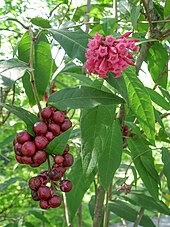
By definition, berries have a fleshy, indehiscent pericarp, as opposed to a dry, dehiscent pericarp. Fossils show that early flowering plants had dry fruits; fleshy fruits, such as berries or drupes, appeared only towards the end of the Cretaceous Period or the beginning of the Paleogene Period, about 66 million years ago. The increasing importance of seed dispersal by fruit-eating vertebrates, both mammals and birds, may have driven the evolution of fleshy fruits. Alternatively, the causal direction may be the other way round. Large fleshy fruits are associated with moist habitats with closed tree canopies, where wind dispersal of dry fruits is less effective. Such habitats were increasingly common in the Paleogene and the associated change in fruit type may have led to the evolution of fruit eating in mammals and birds.[29]
Fruit type has been considered to be a useful character in classification and in understanding the phylogeny of plants.[30] The evolution of fruits with a berry-like pericarp has been studied in a wide range of flowering plant families. Repeated transitions between fleshy and dry pericarps have been demonstrated regularly. One well-studied family is the Solanaceae, because of the commercial importance of fruit such as tomatoes, bell peppers, and eggplants or aubergines. Capsules, which are dry dehiscent fruits, appear to be the original form of the fruit in the earliest diverging members of the family. Berries have then evolved at least three times: in Cestrum, Duboisia, and in the subfamily Solanoideae. Detailed anatomical and developmental studies have shown that the berries of Cestrum and those of the Solanoideae are significantly different; for example, expansion of the fruit during development involves cell divisions in the mesocarp in Solanoideae berries, but not in Cestrum berries.[31] When fruits described as berries were studied in the family Melastomaceae, they were found to be highly variable in structure, some being soft with an endocarp which soon broke down, others having a hard, persistent endocarp, even woody in some species.[30] Fruits classified as berries are thus not necessarily homologous, with the fleshy part being derived from different parts of the ovary, and with other structural and developmental differences. The presence or absence of berries is not a reliable guide to phylogeny.[29] Indeed, fruit type in general has proved to be an unreliable guide to flowering plant relationships.[30]
Uses
Culinary



Berries, defined loosely, have been valuable as a food source to humans since prior to the start of agriculture, and remain among the primary food sources of other primates. Botanically defined berries with culinary uses include:
- Berries in the strictest sense: including bananas and plantains, blueberries, cranberries, the seeds of coffee berries, gooseberries, red-, black- and white currants, tomatoes, grapes and peppers (Capsicum fruits)
- Hesperidia: citrus fruits, including oranges, lemons and limes
- Pepos: cucurbits, including squashes, cucumbers, melons and watermelons
Some berries are brightly coloured, due to plant pigments such as anthocyanins and other flavonoids. These pigments are localized mainly in the outer surface and the seeds.[32] Such pigments have antioxidant properties in vitro,[33] but there is no reliable evidence that they have antioxidant or any other useful functions within the human body. Consequently, it is not permitted to claim that foods containing plant pigments have antioxidant health value on product labels in the United States or Europe.[34][35]
Some spices are prepared from berries. Allspice is made from the dried berries of Pimenta dioica.[36] The fruits (berries) of different cultivars of Capsicum annum are used to make paprika (mildly hot), chili pepper (hot) and cayenne pepper (very hot).[37]
Others
Pepos, characterized by a hard outer rind, have also been used as containers by removing the inner flesh and seeds and then drying the remaining exocarp. The English name of Lagenaria siceraria, "bottle gourd", reflects its use as a liquid container.[38]
Some true berries have also been used as a source of dyes. In Hawaii, these included berries from a species of Dianella, used to produce blue, and berries from black nightshade (Solanum americanum), used to produce green.[39]
History
Cucurbit berries or pepos, particularly from Cucurbita and Lagenaria, are the earliest plants known to be domesticated – before 9,000–10,000 BP in the Americas, and probably by 12,000–13,000 BP in Asia.[38] Peppers were domesticated in Mesoamerica by 8,000 BP.[40][41] Many other early cultivated plants were also berries by the strict botanical definition, including grapes, domesticated by 8,000 BP[42][43] and known to have been used in wine production by 6,000 BP.[44]
Bananas were first domesticated in Papua New Guinea and Southeast Asia. Archaeological and palaeoenvironmental evidence at Kuk Swamp in the Western Highlands Province of Papua New Guinea suggests that banana cultivation there goes back to at least 7,000 BP, and possibly to 10,000 BP.[45][46]
The history of cultivated citrus fruit remains unclear, although some recent research suggests a possible origin in Papuasia rather than continental south-east Asia. Chinese documentary records show that mandarins and pomelos were established in cultivation there by around 4,200 BP.[47]
Commercial production
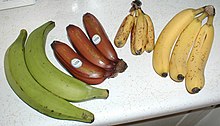
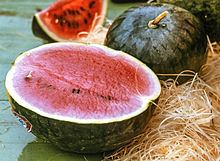

According to FAOSTAT data, in 2013 four of the five top fruit crops in terms of world production by weight were botanical berries. The other was a pome (apples).[Note 1]
| Name | 1000s of tonnes | Fruit type |
|---|---|---|
| Bananas & plantains | 144,592 | Berry |
| Citrus fruit† | 135,761 | Berry (hesperidium) |
| Watermelons | 109,279 | Berry (pepo) |
| Apples | 80,823 | Pome |
| Grapes | 77,181 | Berry |
†Citrus fruit includes, but is not limited to, oranges, lemons, limes, grapefruit (including pomelos), tangerines, mandarins, clementines and satsumas. Oranges make up 53% of the total.
According to FAOSTAT, in 2001, bananas (including plantains) and citrus comprised over 25% by value of the world's exported fruits and vegetables, citrus fruits being more valuable than bananas.[49] Export quantities of fruit are not entirely comparable with production quantities, since slightly different categories are used. The top five fruit exports by weight in 2012 are shown in the table below. The top two places are again occupied by bananas and citrus.[Note 2]
| Name | 1000s of tonnes | Fruit type |
|---|---|---|
| Bananas & plantains | 19,725 | Berry |
| Citrus fruit† | 15,262 | Berry (hesperidium) |
| Apples | 8,271 | Pome |
| Prepared fruit‡ | 7,120 | – |
| Grapes | 4,051 | Berry |
†Citrus fruit includes oranges, lemons, limes, grapefruit (including pomelos), tangerines, mandarins, clementines and satsumas. Oranges make up 43% of the total.
‡Prepared fruit here is "fruit, nuts and peel, including frozen, prepared or preserved, jam, paste, marmalade, purée and cooked fruits, other than those listed separately".[50]
See also
Notes
- ^ Production Quantity data for 2013 for the World total for all items was downloaded to a spreadsheet from FAOSTAT.[48] Items coded 486 to 626, corresponding to fruit, were retained. Data for bananas and plantains were combined, as these are not distinguished by all countries. Data for all citrus fruits were also combined, since some countries provide data under a general heading of "citrus fruit". The resulting table was then sorted and the top five entries used.
- ^ Export Quantity data for 2012 for the World total for all items was downloaded to a spreadsheet from FAOSTAT.[48] As for production, items coded 486 to 626 (but now excluding 564 wine, not present in the production data) were retained. Data for bananas and plantains were combined, as was data for all citrus fruits. The resulting table was then sorted and the top five entries used.
References
- ^ "Berry". Merriam-Webster.
- ^ Kiger, Robert W.; Porter, Duncan M. (2001). "Find term 'berry'". Categorical Glossary for the Flora of North America Project. Retrieved 14 August 2015.
{{cite web}}: Unknown parameter|lastauthoramp=ignored (|name-list-style=suggested) (help) - ^ Pabón-Mora & Litt (2011), p. 1417.
- ^ a b Beentje, Henk; Williamson, Juliet (2010). The Kew Plant Glossary: an Illustrated Dictionary of Plant Terms. Royal Botanic Gardens, Kew: Kew Publishing. ISBN 978-1-84246-422-9.
{{cite book}}: Unknown parameter|lastauthoramp=ignored (|name-list-style=suggested) (help) - ^ Morton, Julia. "Banana". Fruits of Warm Climates. Hort.purdue.edu. Archived from the original on 15 April 2009. Retrieved 16 April 2009.
- ^ Armstrong, Wayne P. "Identification Of Major Fruit Types". Wayne's Word: An On-Line Textbook of Natural History. Retrieved 17 August 2013.
- ^ a b Davis, Aaron P.; Govaerts, Rafael; Bridson, Diane M.; Stoffelen, Piet (2006). "An annotated taxonomic conspectus of the genus Coffea (Rubiaceae)". Botanical Journal of the Linnean Society. 152 (4): 465–512. doi:10.1111/j.1095-8339.2006.00584.x.
{{cite journal}}: Unknown parameter|lastauthoramp=ignored (|name-list-style=suggested) (help) "fruit a berry containing two (rarely one) seeds" - ^ a b c d e Spjut, Richard W. "Classification of Fruit Types". A Systematic Treatment of Fruit Types. The World Botanical Associates. Archived from the original on 29 April 2015. Retrieved 16 August 2015.
{{cite web}}:|archive-date=/|archive-url=timestamp mismatch; 29 March 2015 suggested (help) - ^ Gupta, P.K. (2007). Genetics Classical To Modern. Rastogi Publications. ISBN 978-81-7133-896-2.
- ^ Little, S.A.; Stockey, R.A.; Penner, B. (2009). "Anatomy and development of fruits of Lauraceae from the Middle Eocene Princeton Chert". American Journal of Botany. 96 (3): 637–651. doi:10.3732/ajb.0800318. PMID 21628220.
Roth (1977) acknowledges that fruits of Lauraceae are typically considered drupes, but are better classified as a berry since the 'endocarp' is only made up of a thin, single-celled sclerified endodermis.
{{cite journal}}: Unknown parameter|lastauthoramp=ignored (|name-list-style=suggested) (help) - ^ Kiger, Robert W.; Porter, Duncan M. (2001). "Find term 'drupaceous'". Categorical Glossary for the Flora of North America Project. Retrieved 14 August 2015.
{{cite web}}: Unknown parameter|lastauthoramp=ignored (|name-list-style=suggested) (help) - ^ Stace, Clive (2010). New Flora of the British Isles (3rd ed.). Cambridge, UK: Cambridge University Press. ISBN 978-0-521-70772-5.
{{cite book}}: Invalid|ref=harv(help), p. 277 - ^ Kiger, Robert W.; Porter, Duncan M. (2001). "Find term 'pome'". Categorical Glossary for the Flora of North America Project. Retrieved 21 August 2015.
{{cite web}}: Unknown parameter|lastauthoramp=ignored (|name-list-style=suggested) (help) - ^ Campbell, Christopher S.; Burgess, Michael B.; Cushman, Kevin R. "Amelanchier". In Flora of North America Editorial Committee (ed.). Flora of North America (online). eFloras.org. Retrieved 21 August 2015.
{{cite book}}: Unknown parameter|lastauthoramp=ignored (|name-list-style=suggested) (help) - ^ Kiger, Robert W.; Porter, Duncan M. (2001). "Find term 'aggregate fruit'". Categorical Glossary for the Flora of North America Project. Retrieved 14 August 2015.
{{cite web}}: Unknown parameter|lastauthoramp=ignored (|name-list-style=suggested) (help) - ^ Lu, Lingdi; Boufford, David E. "Rubus". In Wu, Zhengyi; Raven, Peter H.; Hong, Deyuan (eds.). Flora of China (online). eFloras.org. Retrieved 21 August 2015.
{{cite book}}: Unknown parameter|lastauthoramp=ignored (|name-list-style=suggested) (help) - ^ Mabberley, D.J. (1978), "Annonaceae", in Heywood, V.H.; Moore, D.M.; Richardson, I.B.K.; Stearn, W.T. (eds.), Flowering Plants of the World, Oxford University Press, ISBN 978-0-19-217674-5
{{citation}}: Unknown parameter|lastauthoramp=ignored (|name-list-style=suggested) (help) - ^ "Annonaceae". Encyclopedia Brittanica. Retrieved 22 August 2015.
- ^ Kiger, Robert W.; Porter, Duncan M. (2001). "Find term 'multiple fruit'". Categorical Glossary for the Flora of North America Project. Retrieved 14 August 2015.
{{cite web}}: Unknown parameter|lastauthoramp=ignored (|name-list-style=suggested) (help) - ^ The American Heritage Science Dictionary. Google Books. Retrieved 26 August 2013.
- ^ Stearn, W.T. (2004). Botanical Latin (4th (p/b) ed.). Portland, Oregon: Timber Press. ISBN 978-0-7153-1643-6.
{{cite book}}: Invalid|ref=harv(help) p. 376. - ^ Vines, S.H. (1913). "Robert Morison and John Ray". In Oliver, F.W. (ed.). Makers of British Botany (Project Gutenberg EBook ed.). Cambridge University Press. Retrieved 18 August 2015.
- ^ Stearn (2004), p. 35.
- ^ a b c d e f Spjut, Richard W. "The Need for Standardized Meanings to Fruit Terms: An Historical Perspective". A Systematic Treatment of Fruit Types. The World Botanical Associates. Archived from the original on 29 March 2015. Retrieved 17 August 2015.
- ^ a b Linnaeus, Carl (1751). Philosophia botanica (in Latin). Stockholm, Amsterdam: R. Kiesewetter, Z. Chatelain. p. 53.
- ^ Stearn 2004, p. 411.
- ^ Gaertner, Joseph (1788–1792). De Fructibus et Seminibus Plantarum (in Latin). p. XCVII.
Pepo, qui vulgo majorem Cucurbitae fructum denotat, nobis generatim dicitur bacca carnosa, cuius loculamenta ab axi remota, et prope fructus peripheriam ita posita sunt, ut etiam semina, ejus parietibus affigantur. (a fleshy berry, whose locules are remote from the axis, and are so positioned near the periphery of the fruit, that as well as the seeds, they are affixed to its walls, is generally called by us 'pepo', which usually denotes the larger fruit of cucurbits)
- ^ Desvaux, N.A. (1813). "Essai sur les différens genres de fruits des plantes phanérogames". Journal de Botanique, appliqué a l'Agriculture, a la Pharmacie, a la Médecine, et aux Arts (in French). 2: 161–183.
- ^ a b Knapp, Sandra (2002), "Tobacco to tomatoes: a phylogenetic perspective on fruit diversity in the Solanaceae", Journal of Experimental Botany, 53 (377): 2001–2022, doi:10.1093/jxb/erf068, PMID 12324525
- ^ a b c Clausing, Gudrun; Meyer, Karsten; Renner, Susanne S. (2000), "Correlations among fruit traits and evolution of different fruits within Melastomataceae", Botanical Journal of the Linnean Society, 133 (3): 303–326, doi:10.1006/bojl.1999.0340, retrieved 26 August 2015
{{citation}}: Unknown parameter|lastauthoramp=ignored (|name-list-style=suggested) (help) - ^ Pabón-Mora, Natalia; Litt, Amy (2011), "Comparative anatomical and developmental analysis of dry and fleshy fruits of Solanaceae", American Journal of Botany, 98 (9): 1415–1436, doi:10.3732/ajb.1100097
{{citation}}: Unknown parameter|lastauthoramp=ignored (|name-list-style=suggested) (help) - ^ Wrolstad, R.E. (2001). "The Possible Health Benefits of Anthocyanin Pigments and Polyphenolics". Linus Pauling Institute, Oregon State University, Corvallis. Retrieved 7 July 2014.
- ^ Wu, X.; Beecher, G.R.; Holden, J.M.; Haytowitz, D.B.; Gebhardt, S.E.; Prior, R.L. (June 2004). "Lipophilic and hydrophilic antioxidant capacities of common foods in the United States". Journal of Agricultural and Food Chemistry. 52 (12): 4026–37. doi:10.1021/jf049696w. PMID 15186133.
{{cite journal}}: Unknown parameter|lastauthoramp=ignored (|name-list-style=suggested) (help) - ^ "Guidance for Industry, Food Labeling; Nutrient Content Claims; Definition for "High Potency" and Definition for "Antioxidant" for Use in Nutrient Content Claims for Dietary Supplements and Conventional Foods" (PDF). U.S. Department of Health and Human Services, Food and Drug Administration, Center for Food Safety and Applied Nutrition. June 2008.
- ^ EFSA Panel on Dietetic Products, Nutrition and Allergies (NDA)2, 3 (2010). "Scientific Opinion on the substantiation of health claims related to various food(s)/food constituent(s) and protection of cells from premature aging, antioxidant activity, antioxidant content and antioxidant properties, and protection of DNA, proteins and lipids from oxidative damage pursuant to Article 13(1) of Regulation (EC) No 1924/20061" (PDF). EFSA Journal. 8 (2). Parma, Italy: European Food Safety Authority: 1489. doi:10.2903/j.efsa.2010.1489.
{{cite journal}}: CS1 maint: multiple names: authors list (link) CS1 maint: numeric names: authors list (link) - ^ Weiss, E.A. (2002). Spice Crops. Wallingford: CABI. ISBN 978-0-85199-605-9.
{{cite book}}: Invalid|ref=harv(help) p. 122 - ^ Weiss (2002), p. 216.
- ^ a b Erickson, D.L.; Smith, B.D.; Clarke, A.C.; Sandweiss, D.H.; Tuross, N. (13 December 2005). "An Asian origin for a 10,000-year-old domesticated plant in the Americas". Proceedings of the National Academy of Sciences. 102 (51): 18315–18320. doi:10.1073/pnas.0509279102. PMC 1311910. PMID 16352716.
{{cite journal}}: Unknown parameter|lastauthoramp=ignored (|name-list-style=suggested) (help) - ^ Krohn-Ching, V. (1980). Hawaii Dye Plants and Dye Recipes. University Press of Hawaii. ISBN 978-0-8248-0698-9. p. 13
- ^ Aguilar-Melendez, A.; Morrell, P.L.; Roose, M.L.; Kim, S.-C. (1 June 2009). "Genetic diversity and structure in semiwild and domesticated chilies (Capsicum annuum; Solanaceae) from Mexico". American Journal of Botany. 96 (6): 1190–1202. doi:10.3732/ajb.0800155.
{{cite journal}}: Unknown parameter|lastauthoramp=ignored (|name-list-style=suggested) (help) - ^ Kraft, K. H.; Brown, C.H.; Nabhan, G.P.; Luedeling, E.; Luna Ruiz, J. d. J.; Coppens d'Eeckenbrugge, G.; Hijmans, R.J.; Gepts, P. (21 April 2014). "Multiple lines of evidence for the origin of domesticated chili pepper, Capsicum annuum, in Mexico". Proceedings of the National Academy of Sciences. 111 (17): 6165–6170. doi:10.1073/pnas.1308933111.
{{cite journal}}: Unknown parameter|lastauthoramp=ignored (|name-list-style=suggested) (help) - ^ Myles, S.; Boyko, A. R.; Owens, C. L.; Brown, P. J.; Grassi, F.; Aradhya, M. K.; Prins, B.; Reynolds, A.; Chia, J.-M.; Ware, D.; Bustamante, C. D.; Buckler, E. S. (18 January 2011). "Genetic structure and domestication history of the grape". Proceedings of the National Academy of Sciences. 108 (9): 3530–3535. doi:10.1073/pnas.1009363108.
{{cite journal}}: Unknown parameter|lastauthoramp=ignored (|name-list-style=suggested) (help) - ^ Vergano, Dan. "Grapes domesticated 8,000 years ago". USA Today. Retrieved 17 August 2015.
- ^ "Oldest Winery Unearthed in Armenian Cave". Discovery News. Retrieved 17 August 2015.
- ^ "Tracing antiquity of banana cultivation in Papua New Guinea". The Australia & Pacific Science Foundation. Archived from the original on 29 August 2007. Retrieved 18 September 2007.
- ^ Denham, T.P.; Haberle, S.G.; Lentfer, C.; Fullagar, R.; Field, J.; Therin, M.; Porch, N.; Winsborough, B. (2003). "Origins of Agriculture at Kuk Swamp in the Highlands of New Guinea". Science. 301 (5630): 189–193. doi:10.1126/science.1085255. PMID 12817084.
{{cite journal}}: Invalid|ref=harv(help); Unknown parameter|lastauthoramp=ignored (|name-list-style=suggested) (help) - ^ Liu, Y.; Heying, E.; Tanumihardjo, S. (2012). "History, Global Distribution, and Nutritional Importance of Citrus Fruits". Comprehensive Reviews in Food Science and Food Safety. 11 (6): 530–545. doi:10.1111/j.1541-4337.2012.00201.x.
- ^ a b "Download data". Food and Agriculture Organization of the United Nations Statistics Division (FAOSTAT). Retrieved 22 August 2015.
- ^ "Overview of World Banana Production and Trade". FAO.org. Retrieved 11 August 2015.
- ^ "Definition and Classification of Commodities: 8 Fruits and derived products". Food and Agriculture Organization of the United Nations. Retrieved 22 August 2015.

